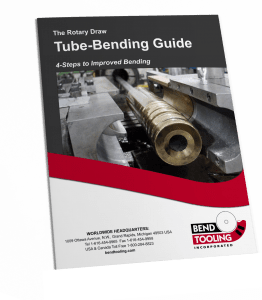B = degree of bend
E = feathered edge thickness
Fb = bend difficulty factor
Fd = “D” of bend
Fw = wall factor
Kr = constant for rigidity
Ks = constant for minimum clamp length
Kz = constant for feathered edge
Lc = clamp length
Lp = pressure die length
Mb = mandrel ball diameter
Md = mandrel nose diameter
Mm = mandrel body diameter
Mr = mandrel nose radius
Pe = percentage of elongation at arc
Pt = percentage of wall-thinning
Pw = wall thickness after thinning
R = centerline radius
Ri = inside radius
Ro = outside radius
S = maximum set-up depth
T = tube outside diameter
Ti = tube inside diameter
W = wall thickness
Wi = thickness of inside lamination
Wo = thickness of outside lamination
Ti = T – ( W x 2 )
Ri = R – ( T / 2 )
Outside radius:
Ro = R + ( T / 2 )
Fw = T / W
“D” of bend:
Fd = R / T
Where “Kr” = a constant for material rigidity (assign the same value to “Kr” as you would to calculate pressure die length; a value of 2 is suitable for most applications; click here for more information) and “n1” through “n4” are values to adjust the weight of each factor in the equation (see below for our recommended weighting):
General formula: Fb = [ ( n1 x Kr ) + ( n2 x Fw ) + ( ( n3 x B ) / 180 ) ) ] / [ n4 x Fd ]
Formula with recommended weighting: Fb = [ 2Kr + .2Fw + ( B / 180 ) ] / [ Fd ]
Note: A bend difficulty rating (calculated with our recommended weighting) of 7 or less indicates a bend that is relatively simple to produce with the rotary-draw method. Factors in excess of 7 typically require either additional precision in set-up or close attention during production in order to hold the set-up parameters.
Wall-thinning of extrados at outside radius after bending (rule of thumb only):
Where “Pt” = percentage of wall-thinning and “Pw” = targeted thickness of wall after thinning out from bending:
Pt = ( Ro – R ) / Ro
Pw = W x ( 1 – Pt )
Percentage of elongation at arc of the bend (rule of thumb only):
Pe = ( Ro / R ) – 1
Mandrel nose diameter for single-wall tubing:
Md = T – ( W x 2.21 )
Mandrel nose diameter for double-wall tubing:
Where “Wo” = wall thickness of outside lamination and “Wi” = wall thickness of inside lamination:
Md = ( T – ( Wo x 2 ) ) – ( Wi x 2.21 )
Mandrel nose radius:
if Fw .006* then E = T x Kz else E = .006*
* Inches. For metric applications, substitute .15 millimeters.
Clamp length:
Where “Kr” = a constant for material rigidity (assign a value of 2 to “Kr” for most applications; click here for more information) and “Ks” = a constant limiting the minimum clamp length depending upon the surface of the cavity (assign to “Ks” the value of 2 for smooth cavities and 1 for serrated cavities; click here for more information):
if ( T x ( Kr x 2.5) ) – R

